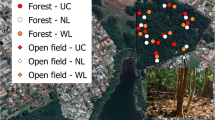Abstract
Dispersal of ornithochorous seeds from isolated forests in the phosphate mining region of central Florida, U.S.A., were studied for two seasons (July to November) to determine patterns of dispersal. Three separate studies included (1) dispersal directly from forest edges to early successional herbs; (2) standardized perches (2 m high post with a crossbeam); and (3) snags (dead trees, 11.3±2.8 m high, 21.4±23.3 stem branches). Perch availability was more important than distance in predicting seed types and quantities of bird-dispersed seeds. The greatest concentration of bird-dispersed seeds were found under standard perches (255±249 seeds/m2/fall) followed by snags (147±85 seeds/m2/fall) and early successional vegetation (3.0±4.1 seeds/m2/fall). Seed quantities dispersed to snags were positively correlated with the number of stem branches on snags. Seeds beneath standard perches were significantly lighter and less diverse than those found beneath snags. This difference is attributed to the larger percentage of forest or later successional species found beneath snags (73%) as compared to the standard perches (15%). Perches and vegetative structural development should facilitate ecological succession by increasing the quantity, quality and diversity of seed deposition.
Similar content being viewed by others
References
Auclair, A. N. & Cottam, G. 1971. Dynamics of blackcherry (Prunus serotina) in southern Wisconsin forests. Ecol. Monogr. 41: 153–177.
Boyer, W. D. 1958. Longleaf pine dispersal in south Alabama. J. For. 56: 265–268.
Clements, F. E. 1916. Plant succession: An analysis of the development of vegetation. Carnegie Institute of Washington Publication No. 242: 1–512.
Connell, J. H. & Slatyer, R. O. 1977. Mechanisms of succession in natural communities and their role in community stability and organization. Am. Nat. 111: 1119–1144.
Debussche, M., Escarré, J. & Lepart, J. 1982. Ornithochory and plant succession in mediterranean abandoned orchards. Vegetatio 48: 255–266.
Egler, F. E. 1954. Vegetation science concepts. 1. Initial floristic composition: a factor in old-field vegetation development. Vegetatio 4: 412–417.
Erdelen, M. 1984. Bird communities and vegetation structure: I. Correlations and comparisons of simple and diversity indices. Oecologia 61: 277–284.
Fleming, T. H. & Heithaus, R. 1981. Frugivorous bats, seed shadows, and the structure of tropical forests. Biotropica 13 (suppl.): 45–53.
Glyphis, J. P., Milton, S. J. & Siegfried, W. R. 1981. Dispersal of Acacia cyclops by birds. Oecologia 48: 138–141.
Guevara, S., Purata, S. E. & Van derMaarel, E. 1986. The role of remnant forest trees in tropical secondary succession. Vegetatio 66: 77–84.
Herrera, C. M. 1982. Seasonal variation in the quality of fruits and diffuse coevolution between plants and avian dispersers. Ecology 63: 773–785.
Jemison, G. M. & Korstian, C. F. 1944. Loblolly pine seed production and dispersal. J. For. 42: 734–741.
Kitching, R. 1971. A simple simulation model of dispersal of animals among discrete habitats. Oecologia 7: 95–116.
Livingston, R. B. 1972. Influence of birds, stones and soil on the establishment of pasture juniper, Juniperus communis, and red cedar, J. virginiana, in New England pastures. Ecology 53: 1141–1147.
MacArthur, R. H. & MacArthur, J. W. 1961. On bird species diversity. Ecology 42: 594–598.
Martin, A. C., Zim, H. S. & Nelson, A. L. 1951. American wildlife and plants. McGraw-Hill, New York.
McAtee, W. L. 1947. Distribution of seeds by birds. Am. Midl. Nat. 38: 214–223.
McClanahan, T. R. 1986. The effect of a seed source of primary succession in a forest ecosystem. Vegetatio 65: 175–178.
McDonnell, M. J. & Stiles, E. W. 1983. The structural complexity of old field vegetation and the recruitment of bird-dispersed plant species. Oecologia 56: 109–116.
McDonnell, M. J. 1986. Old field vegetation height and the dispersal pattern of bird-disseminated woody plants. Bull. Torr. Bot. Club 113: 6–11.
McQuilkin, W. E. 1940. The natural establishment of pine in abandoned fields in the Piedmont Plateau region. Ecology 21: 135–149.
Monk, C. D. 1965. Southern mixed hardwood forests in north central Florida. Ecol. Monogr. 35: 335–354.
Monk, C. D. 1966. An ecological study of hardwood swamps in north central Florida. Ecology 47: 649–654.
Randall, A. G. 1974. Seed dispersal into two spruce-fir clearcuts in eastern Maine. Res. Life. Sci. 21: 1–15.
Roe, D. F. 1960. Douglas-fir seed dispersal in northwestern California. Technical paper No. 49, USDA Forest Service, Pacific Southwest Forest and Range Experiment Station, Berkeley.
Routledge, R. D. 1979. Diversity indices: which ones are admissible? J. Theor. Biol. 76: 503–515.
Rushton, B. T. 1983. Ecosystem organization in phosphate claysettling ponds. Master's Thesis, University of Florida, Gainesville.
Simpson, E. H. 1949. Measurements of diversity. Nature 163: 688.
Schnoes, R. S. & Humphrey, S. R. 1980. Terrestrial plant and wildlife communities on phosphate-mined lands in central Florida. Special Scientific Report No. 3. Office of Ecological Services, Florida State Museum, Gainesville.
Smith, A. J. 1975. Invasion and ecesis of bird-disseminated woody plants in a temperate sere. Ecology 56: 19–34.
Veno, P. A. 1976. Successional relationship of five Florida plant communities. Ecology 57: 498–508.
Uhl, C., Clark, H., Clark, K. & Maquirino, P. 1982. Successional patterns associated with slash-and-burn agriculture in the upper Rio Negro region of the Amazon Basin. Biotropica 14: 249–254.
Yarranton, G. A. & Morrison, R. G. 1974. Spatial dynamics of a primary succession: nucleation. J. Ecol. 62: 417–428.
Author information
Authors and Affiliations
Rights and permissions
About this article
Cite this article
McClanahan, T.R., Wolfe, R.W. Dispersal of ornithochorous seeds from forest edges in central Florida. Vegetatio 71, 107–112 (1987). https://doi.org/10.1007/BF00044824
Accepted:
Issue Date:
DOI: https://doi.org/10.1007/BF00044824




